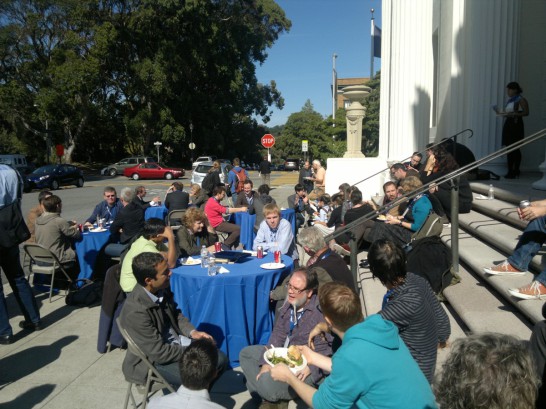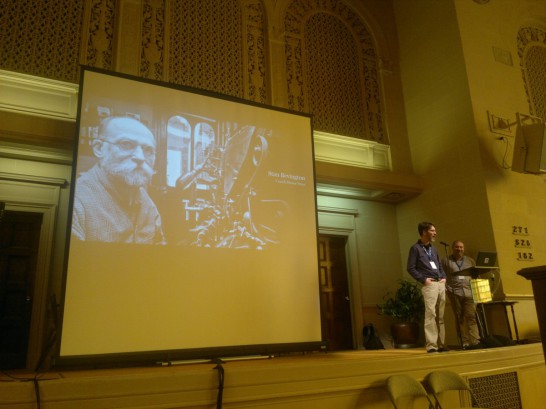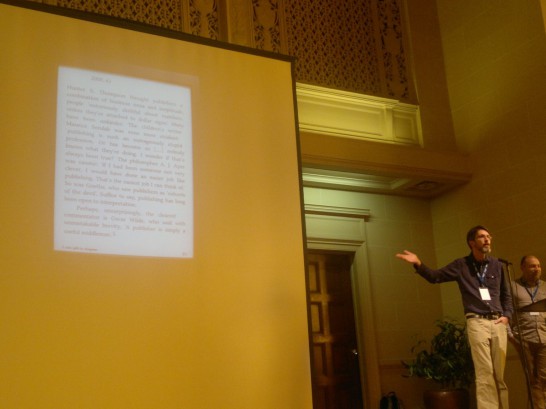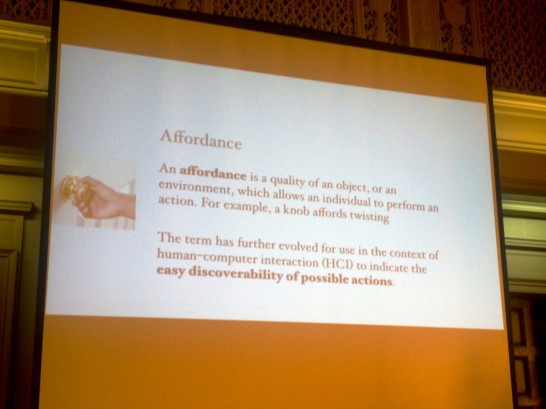Here are live conference notes taken Thursday October 25th during the Books in Browsers 2013 conference at the Internet Archive, San Francisco.
See an index of my live notes here.
Usual live blogging disclaimer :
These are informal notes taken by me, Manuel Schmalstieg, at the event, and may or may not be similar to what was said by the people who spoke on these topics. Probably if something here is incorrect it is because I mistyped it or misunderstood, and if anyone wants corrections, they should email me – or post a comment. Thanks!
TOC:
The Craft of the Book in the Age of the Web
with John Maxwell, Simon Fraser University and Haig Armen, Lift Studios
I’m John Maxwell, teach publishing
we want to talk about the craft of the book in the age of the web.
we’re in position to reflect a little bit on what
we’re teachers, have a vested interest in the future of publishing.
books in browsers make sense, but do browsers actually need book?
is literature, in a book, and publishing on the web?
last year: impression that literature was moving forward, taking off, leaving publishing behind, leaving the book behind.
Richard Nash wrote a beautiful article about the business of literature. James Bridle has made an interesting case, the last couple of years, that the literature exists in the network – the internet + us.
on top of that, another layer: the schadenfreude, about the slow publishing industry being eaten by startups.
and yet, we love books, right.
there’s a self-identification of book people. what attracts students to us is not what we teach – it’s a self identification. what they love most is books and literature. and they want to make a career out of this.
all those people are savvy digital natives.
the people in this room are not here because you want to save the publishing industry. you are here because you love books.
publishing is an industrial activity. it’s *the* prototypical industrial activity. and literature is certainly about art. but there’s this third category: craft.
there is a craft element about making things. things that last, are durable. that makes this grand tradition, that is not just a bunch of ideas- it’s a tradition of making things well.
craft is organized practice. organized around a common discourse, peer to peer collaboration. it unfolds in time. it’s about making things and sharing them. critique, learn from. it’s possibly the greatest tradition of our culture: making cultural expression that lasts.
some examples of research we are doing:
Coach House Press, est, 1965.
Printer: Stan Bevington.
learned the linotype machine. was dark room innovator. a thinkerer. gathered people around him in the late 1960s.
a lovely example of a institution around that grand tradition.
a nexus where culture happens. the interesting thing about the Coach House: in 1974, they went digital, in a big way. through the 70s and 80s, they developed they own typesetting software, software startup 1984. big name in the development of markup. thinkers, makers, hackers- an unbroken chain.
aim: how to make better, books, hight quality printing.
I worry that we are going to lose that tradition. as literature goes through the digital keyhole. the big global market. and we end up with the paradigm that amazon has defined.
This is good enough for the biggest publisher on the world. they could make the typography of the kindle better. but the craft tradition does not matter for amazon.
“I don’t think good enough is enough.
good is the enemy of great.
there’s evidence that a lot of people are working on craft, that granular level of “pushing pixels”, and making sure they are going in the right direction.
will talk about how we present the problems of digital publishing to our students.
publisher: looking to let things flow into templates. they are just “good enough”. quick and easy, template driven. but everyone seems to be still imitating the printed page. this will lead to skeumorphism.
i would like you guys to think of the diff between an affordance, and skeumorphism.
An affordance is a good thing- a skeumorphism, not so good.
Good example: the page turn, that we cant get away from.
these skeumorphisms limit us. in a perfect world, an affordance is a metaphor, used in a subtle way. heavy-handily, it becomes skeumorphic.
the handcraft of the web
a lot of designers do that, but i feel it’s not there in publishing yet.
i had the good fortune of working at CBC Radio 3. we were trying to touch a young audience. we started by making radio, we quickly moved to the web.
this is the 100rd edition of radio3s digital magazine. yeas, it was made in flash. i believe it was the right thing to do in that time, to layer all that information:
text, type, image, and a soundtrack throughout.
we made that 100page book-magazine every week. so it was appropriate for the web.
it did well. it was actually recognized more outside of Canada than within.
just finding the good balance was not good enough. we needed the user to find his own balance.
the only thing: it was a closed platform, not very semantic. it was 10 years.
other example:
A social book
by alexandra samuel
yet another “social book”, but rather than to make another platform, we wanted to make a little system, using open source, that could be reused.
we received a grant to work on this, and we noticed that commentary is marginalized. we wanted to bring it back into the original text, without being disruptive.
THe text was being written by alexandra on a blog, and then turned into a book.
some screengrabs from the app:
a navigation system to pinch down, year by year.
you can pinch open the …
used wordpress as the comment repo.
were crafting experience
teaching experience. 10 years ago i was the techie guy explaining the web to publishers. today, i am explaining the tradition of the book to young media people.
we want to end with a call to restore that craft tradition, and build a bridge.
Pressbooks
with Hugh McGuire
Pressbooks, is a content management system for books.
outputting epubs, mobis and pdf.
I started pressbooks in 2013, had the alpha in 2011. all pressbooks books have a native web version out of the box.
a book i did with Brian O’Leary: Book, A Futurist’s Manifesto.
about open-sourcing pressbooks: it’s on github, you can install it on your wordpress system.
the third thing that excites me: with an online CMS, you have automatically a powerful web based API.
Example (not done in Pressbooks):
Dracula dissected: can be navigated by character, location.
Publishers don’t care — except Kate Pullinger and Megan.
it’s great to see people doing those experiments.
the exciting thing to me – all those formats, (()) are all generated from HTML and CSS.
the conclusion, a year after we launched. publishers and authors are interested in 1) saving money, and b) making money.
we are talking mostly with self-publishing authors, and small presses.
On the PDF side of building books with CSS+HTML: all of are deeply committed to the book itself. the most exciting way: to take a very webby interface, and to make print outputs.
example. backgrounds, textboxes.
we use PrinceXML to generate the PDF. the amazing thing is how much you can start doing with the new paged-media CSS3.
It can handle page numbers, floating figures.
The point: you can come to a very good print output using CSS and HTML.
It’s amazing how much power there is already in the CSS spec.
But when i show it publishers, they notice windows, orphans, bad breaks, bottom balancing…
widows and orphans can be controlled in CSS. but there’s a big penalty in bottom-balancing – i learned what it is two months ago.
A typographer would say: “that’s not enough, my craft gene says no”!
There are ways to do this. You can use a SPAN in some other paragraph, with some css – .loose letter-spacing, word-spacing…
plea to the W3C: find out a way to do bottom-balancing.
I have been reflecting about what the conclusion is of this. The group of people deeply committed to the book as an artefact, but also to the web.
As we get PressBooks closer to what publishers need.
The Business of Culture in our Post-Industrial Times
with Richard Nash, Cursor Books
I will attempt to do an improvised, verbal version,
to begin with i will allude to corey’s talk at the beginning of the day, (pre-industrial times), but i will not go as far back.
the era before books were industrially mass-produced. we had time where writers made a living, by being able to read and write.
the one point in history where they were guaranteed an income.
but the role of the writer was not to be a thought leader, a conqueror of words. he basically was a machine, a scribe through which the word of god, or of locality were preserved. the writer effectively was the printing press. a “scribed laborer”, a calligrapher.
the advent of the book was catastrophic. the entire universe of writers were out of a job, unemployed. yet somehow the supply of writers did not decrease.
it goes against the economical understand of supply and demand. the writers, the scholars, the poets, started gathering around the printing presses.
that increase in the supply of writing came because the book enabled greater literacy. so the increase in the supply of things *to read*, brought an increase of people wanting to write.
and what happened, as socrates/plato, the practical reaction begins with censorship. whether it’s the queen or england, or different dukes or bishops in what would become germany.
((Img: decree for control of printing, 1637))
This becomes as a political act, but evolves in an economic act. the printers were in competition with each other. we have here the beginnings of copyright.
the printers formed informal cartels, where they agreed not to print each other’s books, and bring down the price of books. these cartels (mafia-like) were successful in imposing an informal copyright. they diminished the cost of production, but maintained the price of book. but had huge upfront costs.
In England: Act for the Encouragement of learning.
English parliament: “If anyone is to run cartels around here, it’s gonna be us”.
Copyright never took off in germany before the 19th century. partly because there was no germany. there were multiple groups of printers requiring protection. there was not an economic motivation for copyright, but an esthetic, philosophical one. the movement of romanticism, and the concept of genius.
slide: Goethe.
the late 18th, early 19th century german writers came up with the idea that the great artifacts come not from society, but from the individual. that was a polemic. some admitted they were standing on the shoulder of giants. but with the absence of economic rationale for copyright, they applied a philosophic rationale.
what to do with copyright in an era where one does not need large amounts of capital?
in europe, there is something called moral rights. the author having a “moral authority” to forbid people to screw with it. not because of economics, but a Kantian idea of how things “should be”.
my bridge from my history-channel slides is Aldus, the printer, also the company who produced the PDF. that’s the moment where we went from scarcity to abundance.
between 1990 – 1997, tenfold increase of us productions: advent of desktop publishing.
now, we are beginning to face the …
we are beginning to face the dissent of the governed. they are slowly retrieving consent.
what therefore may be the business model that can replace copyright. and how to replace the moral rights of the author.
Craft
(aura)
referring to covers, package design, the blurb, the copy editing, the proofreading, on top of that, the work around annotation.
all those are service activities.
Authenticity
(trademark)
some authenticity can be derived from craft. the sense that other people were there, made it into a finer experience.
the sense there is a team of people that participate in it.
Pleasure
(UX)
*********




